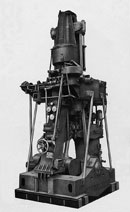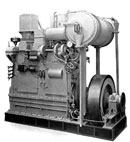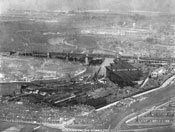 |
|||||||
| A BRIEF HISTORY OF THE DOXFORD ENGINE  Type of vessels built on river 1870 The foundation of Doxford as a shipbuilding concern started in 1840 when William Doxford began building wooden ships at Coxgreen. The size of the vessels built was not large, but the company managed to servive a depression, which put over thirty Sunderland Shipbuilders out of business. In the 1850's shipbuilders were considering iron hulls with steam propulsion and Doxford moving with the times and no doubt thinking of larger ships, moved to Pallion down river in 1857 and opened a A larger site at Pallion was purchased in 1870 and five berths occupied what was known as the ‘WestYard' William Doxford's two elder sons, William Theodore (later Sir William) and Alfred, joined their father in partnership. Robert and Charles, the two younger sons followed into the firm. Robert was the Engineer in the family and served his apprenticeship under Sir William Allan at the North-Eastern Marine Engine Works near mouth of the river.  Torpedo Boat 'ELRAYO' 1187 Fitted with oil fuel Marine Engine building began at Doxford Engine Works in 1878 when the original engine and boiler works were constructed. The first engines to be built were steam compound, next triple expansion, then quadruple expansion, and later steam turbines. It is interesting to note that in 1886 the Company built, to their own account, a single screw torpedo boat that allowed a speed of 21 knots, the highest speed recorded for that particular type of craft. This vessel ran her trials with a coal burning locomotive boiler which was shortly afterwards converted to oil burning. When one considers the number of steam ships, which were being converted from coal to oil burning sixty years after this experiment, the foresight of the Doxford engineers must be commended. The ship ran successful trials on the new fuel but she was ‘before her time' and was ultimately sold to private ownership. In 1910 fire destroyed the engine works and new premises were built on a much larger scale with new machinery, bringing the Engineering Department up to date. Mr. Karl Otto Keller, a Swiss by birth, joined the Company in 1905 for three years working on gas engine development, which was given up in favour of the diesel idea. The investigation into the diesel motor ship propulsion started and its immense potentialities for efficiency and economy were soon realised. It was also appreciated that there were vastly different conditions under which an engine has to work at sea compared with those on land. The solution was in experiment and research followed by the designs which were amended to suit the new improvements. The first Doxford single piston oil engine was a single cylinder crosshead type, which developed 250 BHP at 130 rpm with a bore of 19.5” and a stroke of 37”. The engine operated on the diesel constant pressure cycle with air injection of the fuel, the compression and maximum combustion being about 500 psi. This represents one unit for an envisaged four-cylinder marine engine of 1000 BHP. Otto Keller returned to Doxford in 1911 and after prolonged and thorough testing and experimental work, a number of design weaknesses were disclosed chiefly in the cylinder heads with thermal loadings and the transmission of the heavy piston loads through the engine structure. Many of these problems sounded the death knell of other similar designs. As a result of the findings, Doxford transferred its attention to the opposed piston principle and under the guidance of Mr. Keller assisted by Mr. W. H. Purdie there emerged a design of the first Doxford opposed piston oil engine, and in 1913 the construction of a single cylinder, opposed piston engine was commenced.  1st Opposed Piston Engine This engine had a bore of 500mm and equal upper and lower strokes of 750mm, designed for a normal rating of 450 BHP at 130 rpm. Tests on this engine commenced in July 1914 and after a period of preliminary operation, the engine completed satisfactorily a 35-day full power endurance test during November and December 1914 supervised by Lloyds Register. The results more than fulfilled Doxford's expectations justified their decision to proceed with a full scale engine. The intervention of the First World War delayed development of this project but nevertheless, during these years Doxford's research team was by no means idle. Although over the years the Doxford Engine came within the category of the slow speed engine, increasing interest in medium and high speed diesel engines, to recall that during 1915-1916 a medium speed single cylinder Doxford opposed piston oil engine, was designed and built and then acquired by the admiralty. This engine developed 400 BHP at 360 rpm in a cylinder of 370mm bore with a total stroke of 720mm employing a differential stroke arrangement the lower piston being 340mm and the upper 330mm.  Special High-speed Submarine Engine 400 H.P. The power obtained represented a considerable increase over the cylinder powers in use by the admiralty at that time which was about 100BHP / cylinder. The reason for the production of this medium speed single cylinder experimental unit was that four sets of six cylinder engines could be arranged in tandem pairs driving twin screws with a total power or 9600 BHP and would occupy about the same machinery space as the turbines in the K class submarines, but would give the same sea speed 21 knots with about half the fuel consumption, this roughly doubling the radius of action. The end of the First World War brought this project to an end and it was not perused further. CONVERSION TO SOLID INJECTION The experimental single cylinder opposed-piston unit was converted from air injection to airless or solid injection of fuel in 1916. This was a departure from the cycle invented by Dr. Diesel and was a tremendous step forward at that time. The Doxford Engine was afterwards referred to as an oil engine. It was soon discovered that with solid injection more time was required for burning the fuel. This was obtained by lowering the compression pressure, thus enabling the fuel to be injected earlier without causing an undesirable increase in maximum combustion pressure. With a compression pressure of about 300 psi and a maximum pressure of 600 psi, the mechanical efficiency increased from 75% to 82% within accompanying reduction in fuel consumption. The 7% improvement came from eliminating a three-stage compression, which was operationally unreliable and by reducing the compression pressure from 600psi to 300 psi. The 600psi waste pressure used for the air injection system. |
|||||||
